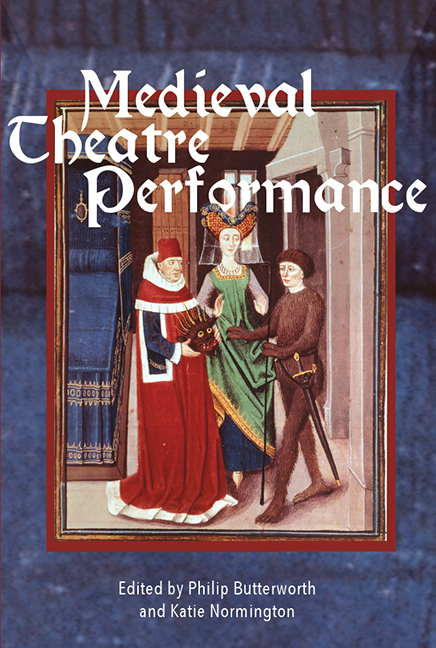Book contents
- Frontmatter
- Dedication
- Contents
- List of Illustrations
- Contributors
- Abbreviations of Principal Sources Cited
- Introduction
- Synopses
- 1 From Archive to Repertoire: The Disguising at Hertford and Performing Practices
- 2 Walk, Talk, Sit, Quit? On What Happens in Netherlandish Rhetoricians’ Plays
- 3 Performing Intrusions: Interaction and Interaxionality in Medieval English Theatre
- 4 Player Transformation: The Role of Clothing and Disguise
- 5 Pavilioned in Splendour: Performing Heaven in Fifteenth-Century Florence
- 6 Living Pictures: Drama without Text, Drama without Action
- 7 Performer-Audience Relationships in Fifteenth- and Sixteenth-century Danced Spectacles
- 8 Decadance in the Late Middle Ages: The Case of Choreomania
- 9 Writing, Telling and Showing Horsemanship in Rhetoricians’ Farce
- 10 Inanimate Performers: The Animation and Interpretive Versatility of the Palmesel
- 11 ‘lyke unto a lyvelye thyng’: The Boxley Rood of Grace and Medieval Performance
- 12 The Mechanycalle ‘Ymage off Seynt Iorge’ at St Botolph's, Billingsgate, 1474
- Bibliography
- Index
2 - Walk, Talk, Sit, Quit? On What Happens in Netherlandish Rhetoricians’ Plays
Published online by Cambridge University Press: 21 August 2018
- Frontmatter
- Dedication
- Contents
- List of Illustrations
- Contributors
- Abbreviations of Principal Sources Cited
- Introduction
- Synopses
- 1 From Archive to Repertoire: The Disguising at Hertford and Performing Practices
- 2 Walk, Talk, Sit, Quit? On What Happens in Netherlandish Rhetoricians’ Plays
- 3 Performing Intrusions: Interaction and Interaxionality in Medieval English Theatre
- 4 Player Transformation: The Role of Clothing and Disguise
- 5 Pavilioned in Splendour: Performing Heaven in Fifteenth-Century Florence
- 6 Living Pictures: Drama without Text, Drama without Action
- 7 Performer-Audience Relationships in Fifteenth- and Sixteenth-century Danced Spectacles
- 8 Decadance in the Late Middle Ages: The Case of Choreomania
- 9 Writing, Telling and Showing Horsemanship in Rhetoricians’ Farce
- 10 Inanimate Performers: The Animation and Interpretive Versatility of the Palmesel
- 11 ‘lyke unto a lyvelye thyng’: The Boxley Rood of Grace and Medieval Performance
- 12 The Mechanycalle ‘Ymage off Seynt Iorge’ at St Botolph's, Billingsgate, 1474
- Bibliography
- Index
Summary
The performance practice of the spel van zinne or zinnespel, the Netherlandish equivalent of the sixteenth-century moral play, seems very straightforward and obvious. Given their overtly discursive character, most of these plays may be characterised as dramatised debates that did not seem to offer their audiences much in terms of visual entertainment or spectacle, except maybe for the disclosure of one or more living images or tableaux vivants, whose function it was to visually underscore that which was said in words.
The meticulous and insightful studies by Wim Hummelen have provided much information about the spatial conditions of the platforms on which zinnespelen were performed, especially concerning the design and use of the one- or two-storey screen placed at the halfway or three-quarter's mark from the front of the stage. A contemporary illustration of such a stage can be found in the printed edition of the zinnespelen performed during the theatre contest held in Haarlem in 1606 (Fig. 1). Characters entered and exited the forestage through the curtains covering the openings in the screen. Except for some zinnespelen that dramatise historical—especially biblical—subject matter, physical action and use of props and décor remained rather limited. Thus, what characters did and what spectators perceived happening in these plays was apparently restricted to walking, talking, sometimes sitting, and, finally, quitting the scene. Given the fact that the genre is allegorical in character with most of its personae delineated as personifications, the zinnespel may even be said to breathe an atmosphere of bloodless deliberation.
Thus, questions arise concerning the kind of experience that the visual and aural perception of these plays offered to their spectators that may explain their popularity throughout the sixteenth century. Clearly the genre was able to reach large urban audiences and to satisfy intellectual and religious curiosity while creating a festive and communal atmosphere. The contention of this chapter is that it was not only topicality that accounted for the zinnespel's appeal, but also (or even more so) its dramaturgical and performative characteristics. Here, some theoretical and methodological positioning is called for. Without denying any play's potential for a purely literary analysis,4 it is hard to block out imagined conditions of what could be seen onstage while reading what was simultaneously said there.
- Type
- Chapter
- Information
- Medieval Theatre PerformanceActors, Dancers, Automata and their Audiences, pp. 35 - 51Publisher: Boydell & BrewerPrint publication year: 2017

